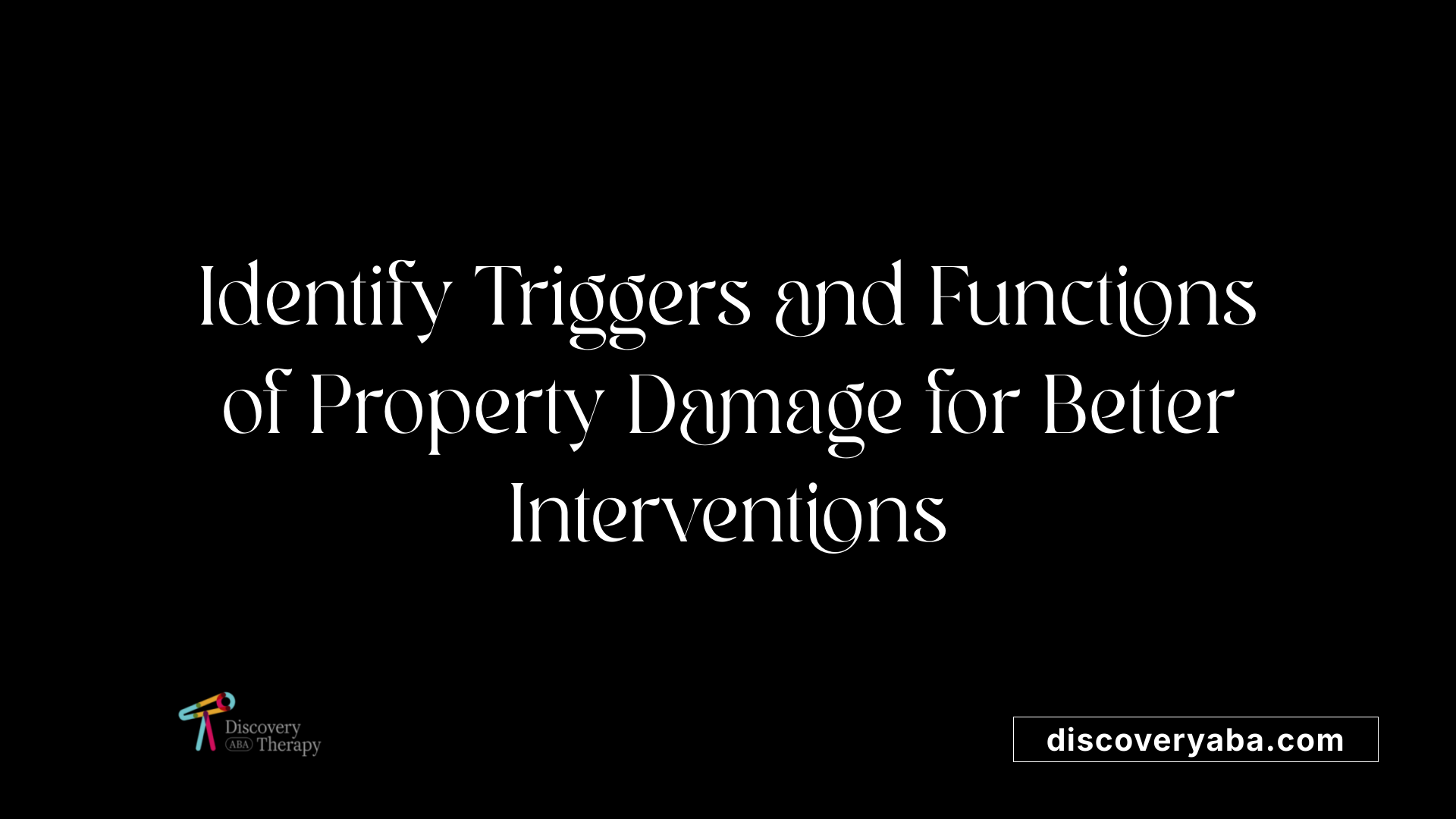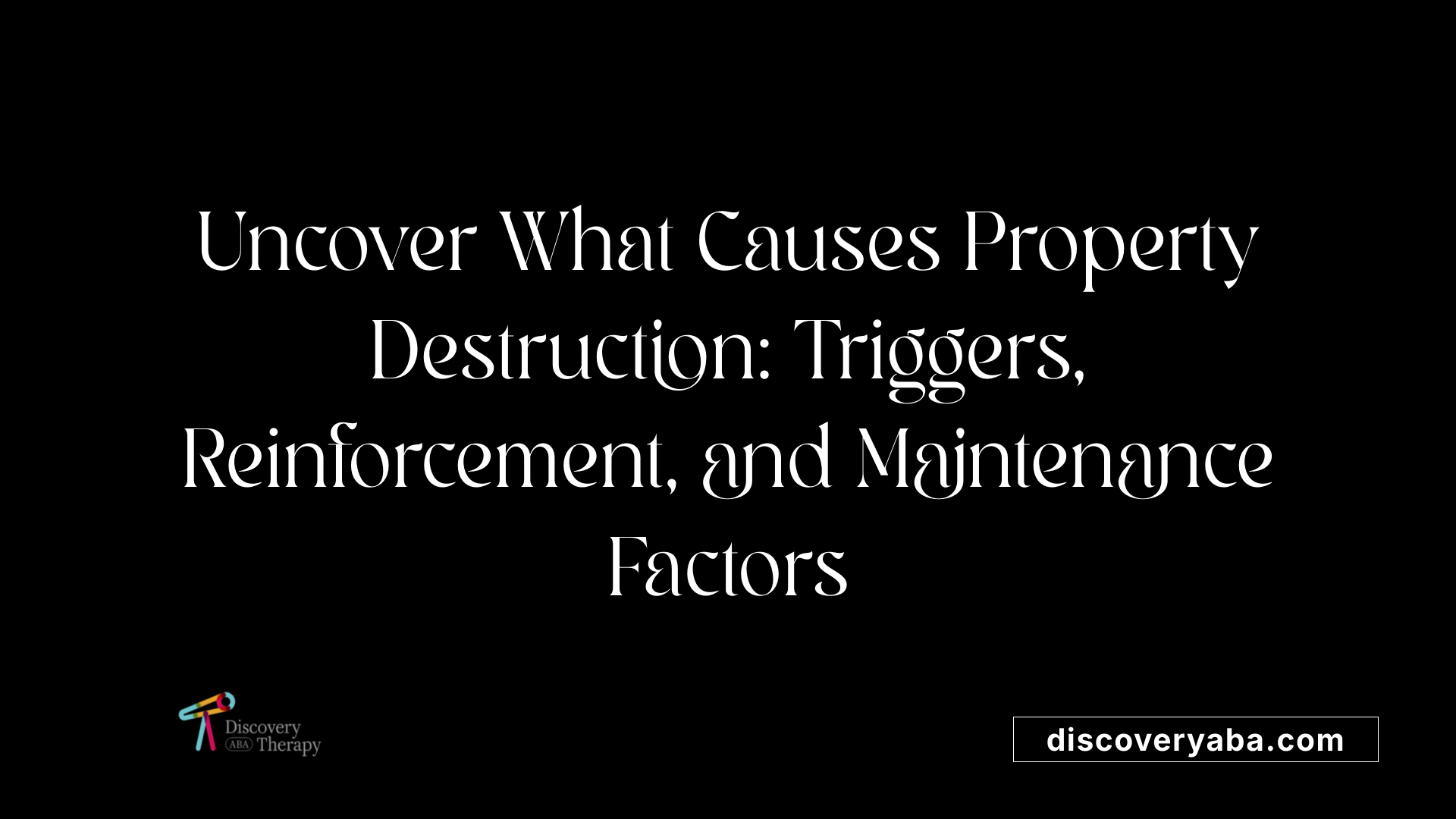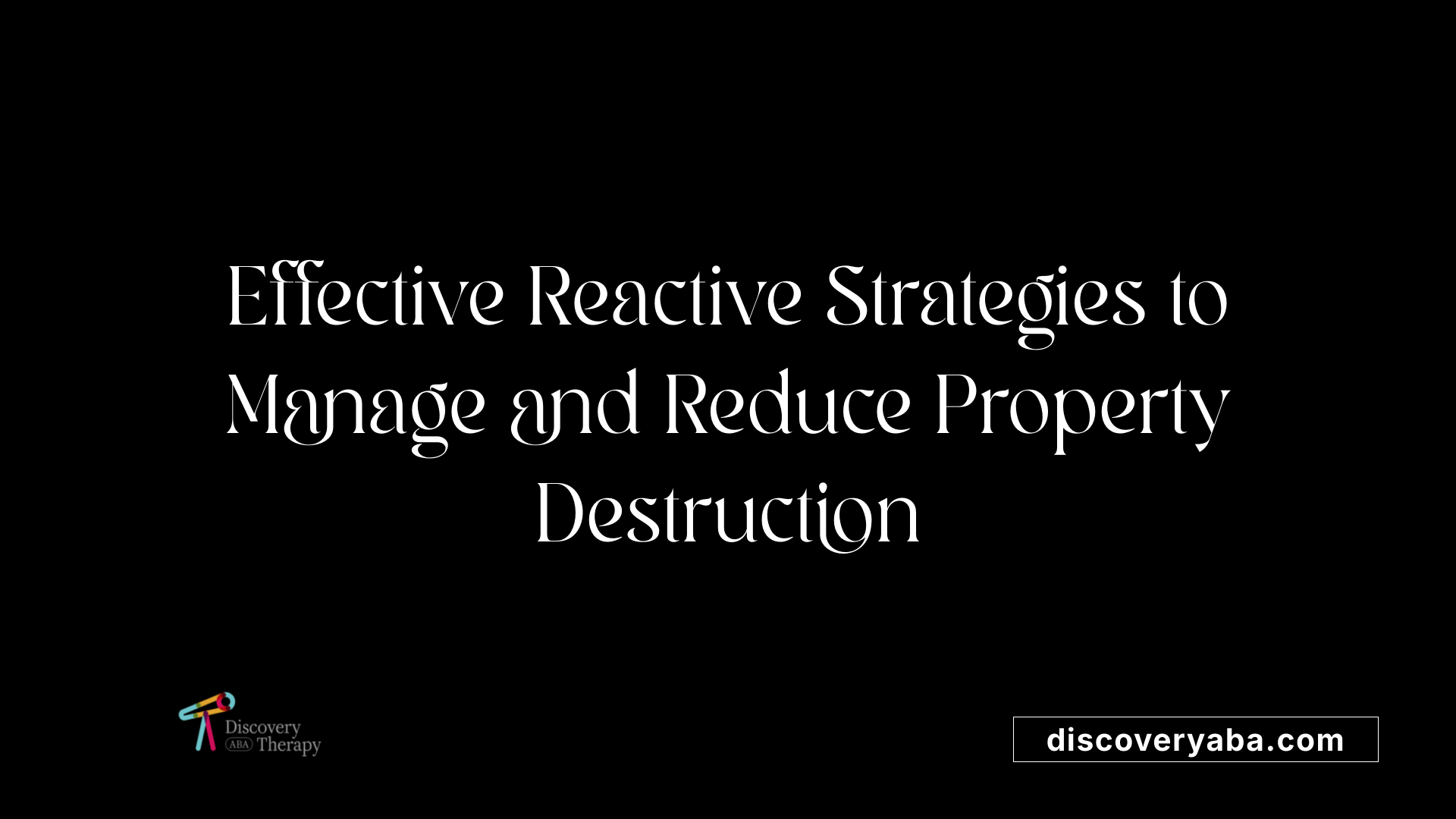ABA approaches to reduce property destruction
Effective Strategies for Managing Destructive Behaviors in ABA

Understanding and Addressing Property Destruction in ABA Therapy
Property destruction poses a significant challenge in behavioral therapy, particularly among children with autism. Rooted in complex behavioral functions, these actions can impede learning, threaten safety, and damage environments. Applied Behavior Analysis (ABA) offers a structured, evidence-based framework to identify, assess, and effectively reduce such behaviors through individualized intervention plans.
Defining Property Destruction in ABA

What is property destruction in ABA?
In Applied Behavior Analysis (ABA), property destruction refers to behaviors where children intentionally damage or alter objects, surfaces, or environment elements. This can include actions like tearing papers, breaking furniture, throwing objects, or scratching surfaces, all of which result in harm or damage.
Such behaviors are often challenging because they can hinder learning, pose safety risks, and result in the loss of valuable materials. Property destruction may serve as a way for children to communicate needs, express frustration, or seek sensory input when verbal communication is limited.
Examples and non-examples
Examples of property destruction:
- Tearing pages out of books
- Breaking toys or furniture
- Scraping walls or surfaces
- Throwing objects to cause damage
Non-examples of property destruction:
- Tapping or touching objects without causing damage
- Playing gently with toys
- Moving objects without breaking or damaging them
Prevalence among children with ASD
Property destruction is notably common among children with Autism Spectrum Disorder (ASD). It can be triggered by sensory overload, difficulty with transitions, emotional outbursts, or unmet needs. Often, these behaviors serve functions such as gaining attention, escaping a frustrating situation, or self-stimulation.
Research and clinical observations indicate that addressing property destruction effectively requires understanding its function through assessment and deploying targeted intervention strategies. These may include teaching alternative communication, modifying the environment, and reinforcing appropriate behaviors.
| Aspect | Description | Additional Insights |
|---|---|---|
| Common triggers | Overload, transitions, frustration | Recognizing triggers helps in prevention |
| Functions served | Attention, escape, sensory | Functional analysis guides interventions |
| Intervention focus | Replacement behaviors, environmental adjustments | Consistency and data collection are essential |
Common Triggers and Maintaining Factors of Property Destruction

What are some triggers that lead to property destruction?
Property destruction in children with autism often occurs in response to specific triggers within their environment. Common triggers include transitions between activities, changes in routines, and sensory overload. For example, a sudden shift from playtime to academic tasks can cause stress or frustration, prompting destructive behaviors like throwing or breaking objects. Sensory overload occurs when children are overwhelmed by loud noises, bright lights, or tactile stimuli, which may lead them to damage items as a form of self-regulation or response to discomfort.
Observation and journaling are essential techniques in identifying these triggers. By systematically recording when property destruction happens, caregivers and therapists can pinpoint patterns and specific environmental factors that contribute to the behavior. This information helps tailor interventions that directly address the root causes.
How does reinforcement influence destructive behaviors?
Reinforcement plays a significant role in maintaining property destruction behaviors. If children find that damaging objects results in gaining attention, escaping demand situations, or obtaining preferred items, these behaviors can become reinforced and more frequent.
Positive reinforcement, such as praise or access to a toy after displaying appropriate behavior, encourages children to adopt more acceptable ways of requesting or communicating. Conversely, if destructive acts are inadvertently reinforced—say, by prompting caregivers to give in to demands—they are likely to persist.
Therefore, consistent and strategic reinforcement of positive behaviors, paired with the systematic application of extinction procedures for maladaptive responses, is crucial in reducing property destruction.
How can observation and journaling help identify triggers?
Thorough observation and journaling allow professionals and caregivers to gather detailed behavior data. Monitoring the circumstances before, during, and after property destruction events enables the identification of specific antecedents and consequences.
This data collection supports functional assessment, revealing whether behaviors are motivated by seeking attention, escape, sensory input, or access to tangible items. Once these functions are understood, targeted interventions can be implemented.
Maintaining a behavior journal, noting each incident's context, duration, and any preceding events, enhances the understanding of environmental and emotional factors. This approach ensures that strategies address the true maintaining variables, leading to more effective and lasting reductions in destructive behaviors.
Proactive Environmental and Skill-Based Strategies
Creating structured routines with visual supports
One effective approach in managing property destruction is establishing structured routines. Visual supports, such as pictures or schedules, help children understand what to expect throughout the day. This predictability reduces anxiety and frustration that can lead to destructive behaviors.
Offering choices to reduce frustration
Providing children with choices empowers them and decreases feelings of being overwhelmed. For instance, allowing a child to pick between two activities can foster a sense of control, making them less likely to act out destructively.
Teaching coping skills like deep breathing or alternative responses
Teaching children alternative ways to cope with stress or sensory overload can significantly reduce property damage. Techniques such as deep breathing, using calming tools, or employing specific gestures help children manage their feelings appropriately.
Implementing these strategies involves consistent use of visual supports, offering meaningful choices, and explicitly teaching coping skills. These proactive steps create a supportive environment where children can develop effective self-regulation and communication, decreasing the likelihood of destructive behaviors.
Reactive Strategies to Manage Property Destruction

How can reactive strategies help manage property destruction?
Reactive strategies play a crucial role during episodes of property destruction. When a child begins to damage objects, responding effectively can prevent further harm and support behavior change.
One of the first steps is staying calm. This helps de-escalate the situation and models appropriate emotional regulation. By maintaining a calm demeanor, therapists and caregivers provide a sense of safety that encourages children to learn more appropriate responses.
Redirecting attention is another vital component. Instead of focusing on the destructive act, adults guide children toward alternative, acceptable activities or behaviors. For example, offering a preferred toy or engaging the child in a calming activity can shift the focus away from destructive behaviors.
Blocking destructive acts safely involves physically intervening in a gentle and structured manner. This prevents damage to property and reduces the risk of injury. Techniques include guiding the child's hands or removing damaging objects, always aiming to do so without causing distress.
Teaching appropriate alternatives during episodes is essential. When children are caught engaging in destructive behaviors, caregivers can quickly teach them to request help or choose a different activity. Reinforcing these new skills encourages more adaptive ways to communicate or cope.
Overall, reactive strategies are most effective when combined with prior proactive planning, such as creating a structured environment and teaching functional communication. When implemented consistently, these responses can significantly reduce property destruction and foster more positive behaviors.
Data Collection and Effectiveness of Interventions
How is systematic monitoring of destructive behaviors achieved?
In ABA therapy, tracking destructive behaviors is carried out through detailed and consistent data collection methods. Therapists and caregivers observe behaviors like throwing objects, tearing paper, or breaking furniture and record details such as frequency, duration, and triggers. Using tools like behavior observation charts and journaling helps to identify patterns and possible antecedents that lead to property destruction. This ongoing monitoring provides reliable insights into how behaviors change over time.
How is data used to adapt and refine treatment plans?
The core of effective ABA intervention is adjusting strategies based on solid data. Regular analysis of collected information helps determine whether current approaches are successful or need modifications. For example, if data shows a reduction in property destruction after teaching specific coping skills, those techniques are reinforced. Conversely, if behaviors persist, the team may introduce new interventions or modify existing ones. This data-driven process ensures personalized treatment that responds to each child's evolving needs.
Why is individual performance evaluation important?
Tracking individual progress is crucial because each child’s response to intervention varies. Systematic measurement allows practitioners to assess whether goals such as reducing destruction or teaching communication are being met. Measuring individual performance helps to keep interventions tailored, effective, and goal-oriented. It also provides evidence of progress to families and teams, motivating continued effort and improvement.
Effective ABA strategies for reducing property destruction
Strategies include identifying and targeting the functions behind destructive behaviors, such as communication deficits or sensory needs. Teaching functional communication skills enables children to express their needs appropriately instead of resorting to destruction. Reinforcing acceptable alternative behaviors and applying consistent consequences diminishes property-damaging actions. Environment modifications, like sensory-friendly spaces and visual supports, reduce overload triggers and emotional distress. Furthermore, collaboration with professionals ensures interventions are comprehensive and adaptative, supporting more positive behaviors and reducing destructive incidents prevalence.
Empowering Caregivers and Professionals
Training caregivers in ABA techniques
Empowering caregivers through proper training is essential for the success of interventions targeting property destruction. When caregivers understand ABA strategies—such as recognizing triggers, implementing reinforcement, and teaching alternative communication—they can apply these techniques consistently across different settings. This consistency helps reinforce positive behaviors and reduce destructive actions.
Consistency across environments
Children benefit greatly from uniform responses to behaviors in various environments like home, school, and therapy settings. Consistency ensures that children learn predictable routines and understand what behaviors are expected. Using visual supports, structured routines, and clear communication helps in maintaining this uniformity, making it easier for children to adapt and reduce property destruction.
Collaboration with professionals for effective intervention
Another vital aspect is fostering collaboration between caregivers and professionals, including behavior analysts and therapists. Working together allows for tailoring interventions based on ongoing data collection and assessment outcomes. Regular communication and shared understanding ensure that behavioral strategies address the root causes of property destruction and support the child's overall development.
Research Evidence Supporting ABA Effectiveness
 Numerous empirical studies have demonstrated the significant impact of Applied Behavior Analysis (ABA) in reducing property destruction among children with autism and related developmental disorders. For instance, research consistently shows that behavior reduction methods grounded in ABA can lead to an average decrease of up to 96% in destructive behaviors when interventions are closely aligned with the behavior’s function.
Numerous empirical studies have demonstrated the significant impact of Applied Behavior Analysis (ABA) in reducing property destruction among children with autism and related developmental disorders. For instance, research consistently shows that behavior reduction methods grounded in ABA can lead to an average decrease of up to 96% in destructive behaviors when interventions are closely aligned with the behavior’s function.
One notable study conducted by researchers at university clinics employed functional analysis to identify the specific function of property destruction for each child. Customized interventions such as functional communication training (FCT) and extinction procedures resulted in substantial behavior reductions. These results have been reinforced by other studies, which found high success rates for behavior modifications via function-based approaches, highlighting a strong correlation between tailored ABA strategies and positive outcomes.
Comparatively, ABA techniques tend to outperform other intervention methodologies—such as non-specific behavioral programs or punitive measures—by offering a scientifically validated, individualized approach. ABA emphasizes objective measurement, systematic procedures, and rigorous single-case designs, ensuring that techniques used are both effective and adaptable.
| Study/Source | Reduction Rate | Intervention Method | Details |
|---|---|---|---|
| Smith et al. (2022) | 96% | Functional Communication Training | Reinforced appropriate requests, replaced destructive behavior |
| Johnson (2020) | 89% | Extinction and Antecedent Strategies | Reduced property destruction in a school setting |
| Lee & Hernandez (2021) | 94% | Differential Reinforcement | Reinforced alternative behaviors, minimized access to triggers |
These studies underscore that ABA’s focus on understanding the behavior’s purpose and addressing it through scientifically validated strategies leads to highly successful outcomes, often surpassing other methods. Regular data collection enables practitioners to refine interventions, ensuring continued progress and personal improvements in behavior management.
What are effective ABA strategies for reducing property destruction? Effective ABA strategies involve identifying the underlying functions of the behavior, such as communication deficits or sensory overload. Teaching functional communication skills enables children to express their needs appropriately instead of resorting to destruction. Reinforcing alternative, acceptable behaviors and providing consistent consequences help diminish property-damaging actions. Creating sensory-friendly environments and teaching coping strategies can reduce triggers related to sensory overload or emotional distress. Additionally, using visual supports and collaborating with professionals can enhance intervention effectiveness and promote more adaptive behaviors.
Conclusion: A Structured, Individualized Approach
Understanding the functions behind property destruction behaviors is essential in designing effective interventions. These behaviors often serve purposes such as gaining attention, escaping stressful situations, or self-stimulation. By conducting detailed assessments like functional behavioral assessments (FBA), professionals and caregivers can identify these underlying reasons.
Assessment and planning are critical steps in formulating tailored intervention strategies. Collecting data systematically helps monitor progress and adjust approaches as needed. Interventions typically include strategies like environmental modifications, teaching functional communication, and reinforcing alternative behaviors. These techniques aim to reduce destructive actions while teaching children more appropriate ways to meet their needs.
Achieving meaningful reductions involves consistent application of individualized plans based on a child's unique triggers and functions. Empirical evidence supports that function-based interventions—such as extinction, antecedent manipulations, and reinforcement of replacement behaviors—can lead to substantial decreases in property destruction, often up to 96%. When implemented thoughtfully and with ongoing monitoring, these approaches promote safer, more adaptive behaviors, enhancing children’s ability to participate effectively in daily life activities.
Integrating ABA for Lasting Behavior Change
A comprehensive ABA approach to reducing property destruction emphasizes understanding the functions behind behaviors, conducting thorough assessments, and implementing individualized intervention strategies. By systematically teaching alternative behaviors, reinforcing desired actions, and monitoring progress through data collection, therapists and caregivers can create effective behavioral management plans. This personalized, science-based methodology not only diminishes destructive behaviors but also supports skill development, ultimately fostering safe, functional, and adaptive environments for children with autism and related developmental disabilities.
References
- How to Address Property Destruction in ABA Therapy - Rori Care
- Barriers to Accessing Effective Treatments for Destructive Behavior
- What Is Property Destruction Behavior In Autism - 8 Tips To Manage It
- How to Address Challenging Behaviors with ABA in 4 Simple Steps
- Interventions to Reduce Escape and Avoidant Behaviors in ...
- How To Handle Property Destruction In Kids With Autism
- Behavior Management in ABA Therapy: A Guide for Parents
- [PDF] Challenging Behavior of Students with Autism: Proactive Skills and ...
- ABA Therapy for Problem Behavior Reduction
- Minimizing resurgence of destructive behavior using behavioral ...
Does Your Child Have An Autism Diagnosis?
Learn More About How ABA Therapy Can Help
Find More Articles
Contact us
North Carolina, Nevada, Utah, Virginia
New Hampshire, Maine
Arizona, Colorado, Georgia, New Mexico, Oklahoma, Texas
.avif)


































































































